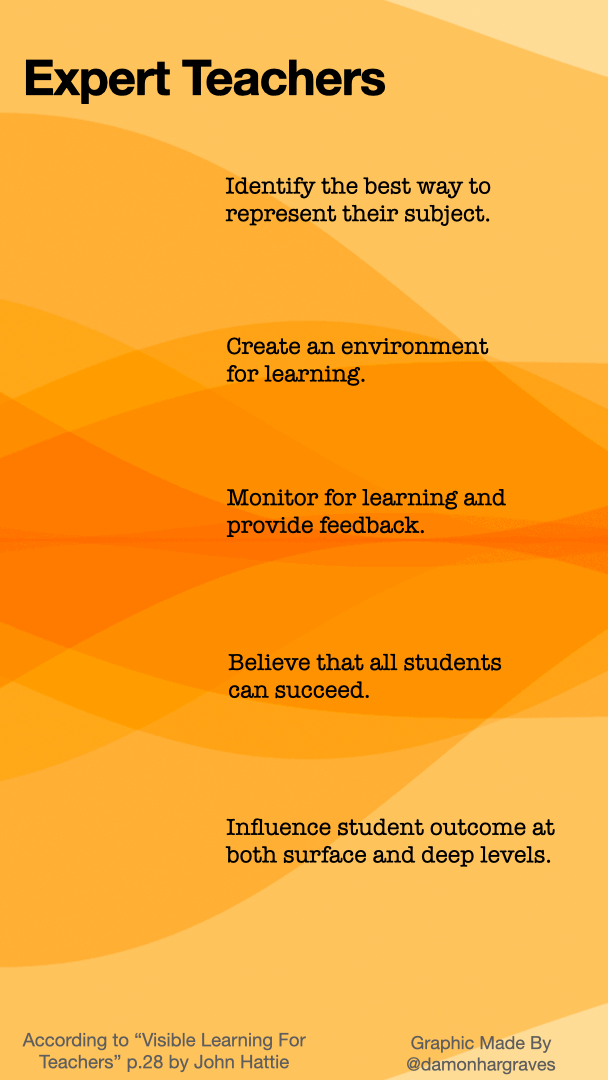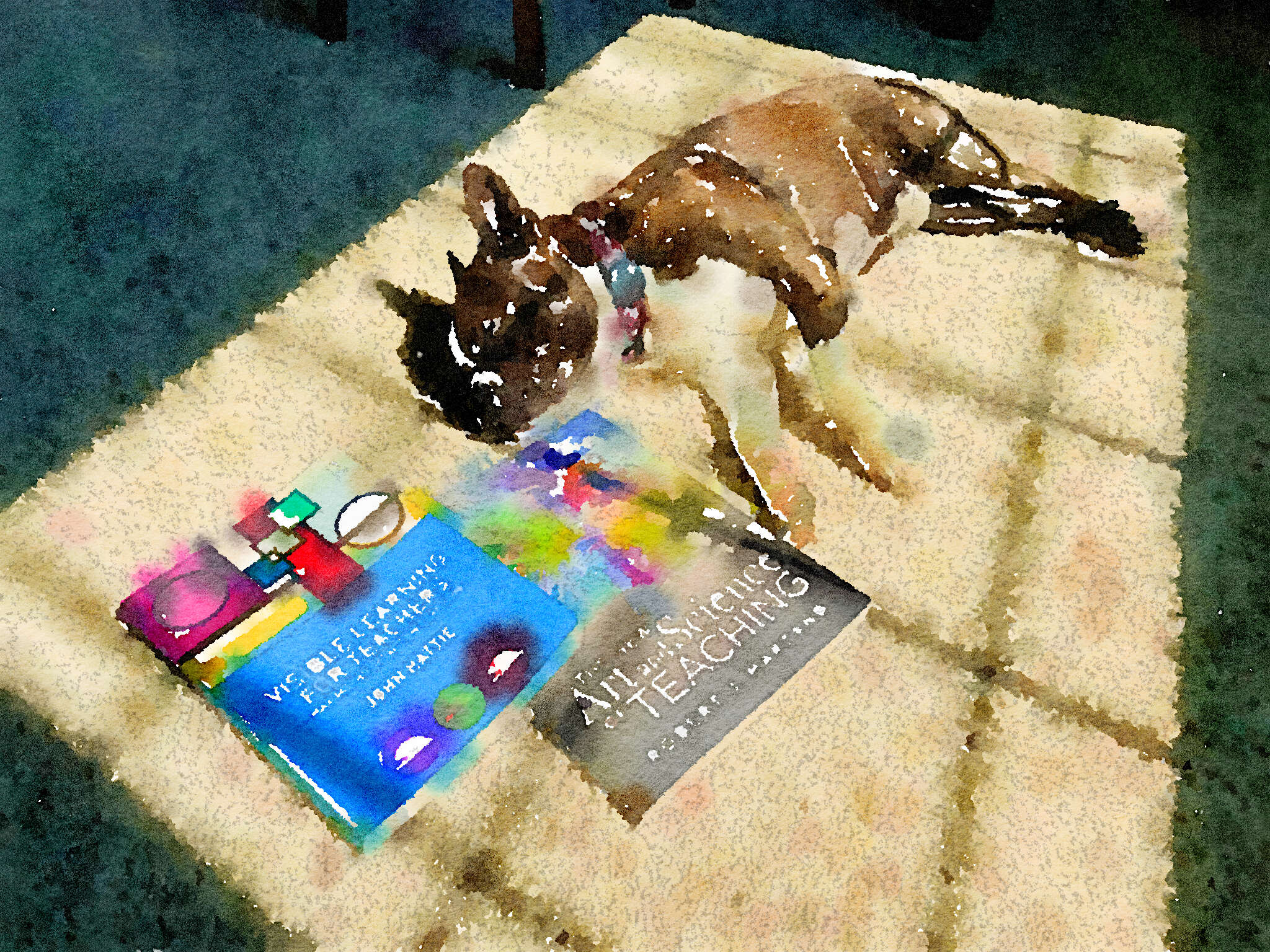This post is published in partial fulfillment of Dr. Sutherland's EDL 755 course at Evangel University.
"Visible Learning for Teachers" and "The New Art and Science of Teaching"
Session 1: June 26, 2022 – Hattie Chapter 1, Marzano Chapters 1 & 2
The beginnings of both of Hattie's and Marzano's books provide an introduction to their philosophies.
Marzano starts off by highlighting his five elements.
- Element 1: Providing Scales and Rubrics
- rubrics are good, scales are generally better
- Element 2: Tracking Student Progress
- observe growth
- track progress
- obtrusive vs unobtrusive assessments
- Element 3: Celebrating Success
- Element 4: Using Informal Assessments of the Whole Class
- whole class
- Element 5: Using Formal Assessments of Individual Students
I have read Marzano many times, and own many many books co-published by him. In this resent reading though I was struck by how his elements correspond to the RTI process so well. Communicate goals, teach, assess for learning and then repeat.
Hattie's book was a new one for me. I've seen the cover dozens of times. I'm sure my district has copies available, but somehow I missed the Hattie train. Here are a few of key points from the first chapter.
- Staffing, pay, class size, curriculum, facilities are not core attributes of successful schooling. Like the 'Intel Inside' sticker that speaks to more than just hardware and software. There are core attributes that make schools successful. (p.1)
- Make student learning visible to teachers, and teaching visible to students.
- This textbook is based off of evidence presented in "Visible Learning" (Hattie, 2009)
- Based off of research from 800 meta-analyses of 50,000 research articles, 150,000 effect sizes, 240 million students.
- "Any intervention can stake a claim to making a difference to student learning" (p.2)
- If you set the bar at "showing growth" then you've basically set the bar at zero, because almost everything shows some growth.
- Visible learning means that there is an effect size of at least 0.40.
- d = 0.40 is the "hinge-point" (h-point) (p.3)
- "Fundamental thesis of the book is that there is a 'practice' of teaching. Practice over science. There is no fixed recipe." (p.5)
What struck me with Hattie is his claim that almost any intervention shows growth. It appears that his major contribution in this book is helping to scientifically set a bar of growth that helps to show that the instruction is helping in a meaningful way. Hattie calls it the hinge-point.
It's interesting to read both of these book together. Marzano's book title includes the word "art", but he seems to be focused on traits that simply show impact. Hattie is looking for meaningful affect. I'm not sure that they totally agree on everything. To use Hattie's own analogy, it appears to me that Hattie wants to know if there is 'Intel Inside' the system, where Marzano may be too focused on the individual hardware and software pieces. I guess I'll find out soon enough.
It's interesting to read both of these book together. Marzano's book title includes the word "art", but he seems to be focused on traits that simply show impact. Hattie is looking for meaningful affect. I'm not sure that they totally agree on everything. To use Hattie's own analogy, it appears to me that Hattie wants to know if there is 'Intel Inside' the system, where Marzano may be too focused on the individual hardware and software pieces. I guess I'll find out soon enough.
Session 2: July 3, 2022 – Hattie Chapters 2 & 3, Marzano Chapters 3 & 4
Hattie continues in these next couple chapters by explaining the process for his meta analysis and then an analysis of teachers as the major influencer in schools.
Chapter 2 The source of the ideas
Chapter 2 The source of the ideas
- p.12 "This chapter introduces the main implications from Visible Learning and the course of ideas for this book."
- describes how the meta analysis process works
- homework has an effect size of d = 0.29 which isn't a visible method
- Question: These meta analysis seem to be totally scattershot. A meta analysis on just "homework by grade level" doesn't seem to be particularly useful to me, especially when I see homework being used in a wide variety of ways. A more interesting question might be, "when is homework effective?"
- p.14 the low homework score should not necessarily be seen as a reason to remove homework, but as an invitation to change the way we do homework/think about homework
- p.15 description of the speedometer
- p.18 "A key premise is that the teacher's view of his or her role is critical." They should be asking about the effect that they are having on learning.
- p.18 "I'm not saying that teachers matter, this is cliche and unsupported...What does matter is that teachers evaluate their effect on learning."
- p.21 "The major argument presented in this book is that when teaching and learning are visible, there is a greater likelihood of students reaching higher levels of achievement."
Conclusions of Visible Learning p.22
- Teacher are among the most powerful influences in learning.
- Teachers need to be directive, influential, caring, and actively and passionately engaged in the process of teaching and learning.
- Teachers need to be aware of what each and every student in their class is thinking and what they know and provide meaningful feedback.
- Teachers and students need to know learning intentions and how well they are attaining these criteria, and where to go next.
- Teachers know that it's not about the knowledge or ideas, but the learner's construction of this knowledge and the creation of ideas.
- School leaders and teachers create an environment where learning is an opportunity and error is welcomed as a sign of learning and exploring knowledge.
- p.23 "Teaching is not "solved" with professional development, a new method, or a band-aid remedy. Good teaching is a way of thinking: 'My role, as teacher, is to evaluate the effect I have.'
Teachers should p.23:
- focus on student cognitive engagement with content
- focus on developing thinking and reasoning that emphasizes problem-solving
- focus on imparting new knowledge and understanding, monitor
- provide timely feedback
- seek feedback from students regarding their progress
- have deep understanding of how we learn
- see learning through the eyes of their students
Chapter 3 Teachers: the major players in the education process
p.28 Teacher subject-matter knowledge had little effect on the quality of student outcomes. (an expert teacher may have similar knowledge about the content as other teachers, but they have a superior understanding of student learning in their class)

Expert teachers...
- can identify the best way to represent their subject
- can create an environment for learning
- monitor for learning and provide feedback
- believe that all students can reach the success criteria
- influence surface and deepen learning outcomes
Marzano continues in his next few chapters.
Chapter 3 Conducting direct instruction lessons
p.29 Direct instruction doesn't have to be non-participatory for students.
- Element 6: Chunking Content
- Teacher presents content in large or small chunks based on student initial understanding
- Students process content between chunks
- Students understand why teacher stops a points
- Students are learning content chunks as the class proceeds
- Element 7: Processing Content
- Processing happens between chunks
- Students consider perspective
- Students collaborate
- Students take notes and review
- Element 8: Recording and Representing Content
- The goal is for students to create an internal representation of the content
Chapter 4 Conducting practicing and deepening lessons
- Element 9: Using Structured Practice Sessions
- procedural knowledge progresses
- cognitive - skill strategy process
- associative - trying out the strategy and personalizing it
- autonomous - fine tuning ability to execute the procedure
- procedural knowledge progresses
- Element 10: Examining Similarities and Differences
- Element 11: Examining Errors in Reasoning


